This project is made possible through the partnership of Water Charity and the National Peace Corps Association. ![]()
Location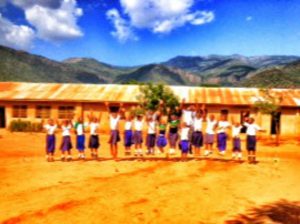
Nkwini, Same District, Kilimanjaro Region, Tanzania
Community Description
Nkwini, a tiny sub-village, sits 5 km away from the main village, Makanya, in the Kilimanjaro region of Tanzania. It is located on the semi-arid flatlands traditionally used as land for Nomadic herders. People from the Pare tribe descended from the mountains to this area because of the rich soil and the promising farming prospects.
Unfortunately, over the years climate, change, and deforestation has negatively impacted the area. The dry season has become drier and longer. People who have depended for years on the fertile soil of Nkwini are consistently let down because of drought, and they are often unable to grow enough food to feed themselves, let alone make a profit off of their labors.
There are very few services in Nkwini: a primary school, a mill, a few small huts with basic commodities, and an incomplete clinic. Life is difficult for its people. Many have started to move, leaving in search of better opportunities. The main sources of income are day labor at the neighboring sisal plantation and the selling of crops, both paying very little. Despite its struggles, the people of Nkwini continue to work hard and are optimistic about the future of their village.
Problem Addressed
Due to deforestation and climate change, the once predictable rains have become uncertain. The average rainfall is 500 ml per year. The systems required to adapt to such unpredictability have yet to be cultivated. Nkwini’s small population relies on two sources of water. The first comes from the neighboring mountain village of Mw’gende. The water is transported through a gravity pipe and stored in a 16,000 L tank.
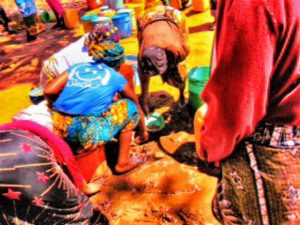 During the dry season, it is common to go more than 4 weeks without water from Mw’gende. A United Nations report states that the minimum water needs per person are 25 L per day. Nkwini’s current water system cannot provide people with enough water for more than two days.
During the dry season, it is common to go more than 4 weeks without water from Mw’gende. A United Nations report states that the minimum water needs per person are 25 L per day. Nkwini’s current water system cannot provide people with enough water for more than two days.
The second source of water comes from Makanya’s boreholes located 5 km away. Wealthier villagers, with private storage wells, hire trucks to transport the water from Makanya to Nkwini. They then charge the villagers double the price of transport. The people of Nkwini have little control over their water situation, leaving them vulnerable to drought and price augmentation.
Project Description
In the sub-village of Nkwini there is a concerning lack of affordable, sanitary drinking and household water. The Rainwater Harvesting Committee proposes to build two circular, above-ground, Ferro-cement rainwater catchment tanks of 30,000 liters each at the primary school and the clinic in town.
Each tank will have a corrugated iron roof and will be connected to a central water point.
Adding these tanks to the existing water structure will help the villagers in times of drought. It will also increase available sources of water in the community, discouraging dependence on and depletion of one. This will 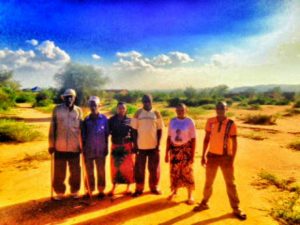 benefit all residents.
benefit all residents.
The masons of the community will be taught how to use the Ferro-cement technology, a more efficient, more durable method, from an expert mason recommended by Empower Tanzania, a local NGO.
The tanks will be opened only after there has been no water available for one week. Each person in the village will be allowed 60 L per week. Each 20 L will cost 200 TZS. 152 of those 200 TZS will go towards replenishing the tank from a neighboring borehole 5 km away. The remaining 48 TZS will go towards the maintenance and repair of the tank.
The actual dispersal of the water will follow the normal process in which households are called forth by neighborhood. This process will be monitored by the Nkwini Water Committee. The building will begin in the beginning of May 2016 and will be finished by the end of June.
The community will contribute water, sand, stones, food for the masons, and a cash contribution, totaling 25% of the total project cost.
Project Impact
This project will benefit 495 people.
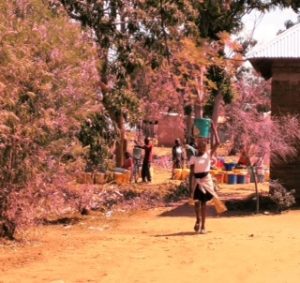 Peace Corps Volunteer Directing Project
Peace Corps Volunteer Directing ProjectKatie Kirkwood
The monitoring and maintenance of this project will be conducted by the Rainwater Harvesting Committee. The first phase will be the acquiring of all necessary materials. This should take no longer than one week. All of which will be done with the committee members and PCV to ensure proper procurement. The chief mason, Godrich Msangi, will partner with a committee member and the PCV for directing the purchases in the Same Town.
After this, the second phase will begin immediately, the building of the first tank for the purpose of educating Nkwini’s local masons in the ferro-cement building. All 5 masons have signed a contract agreeing to participate and to donate a substantial amount of work and time in order to both expand their skill set and better the lives of the people of Nkwini. This phase should take no longer than 2 weeks.
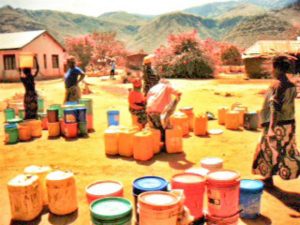 Msangi.
Msangi.The Water Committee will be responsible for collecting whereas the Development Committee will store the money and decide when to use it. Having these two Committees working together ensures transparency and accountability with the funds collected from the tanks. They will act as a check and balance for each other.
This project has been funded by an anonymous donor. Please donate to our other projects in our East Africa Water and Sanitation Program.
This project has been completed. To read about the conclusion, CLICK HERE.